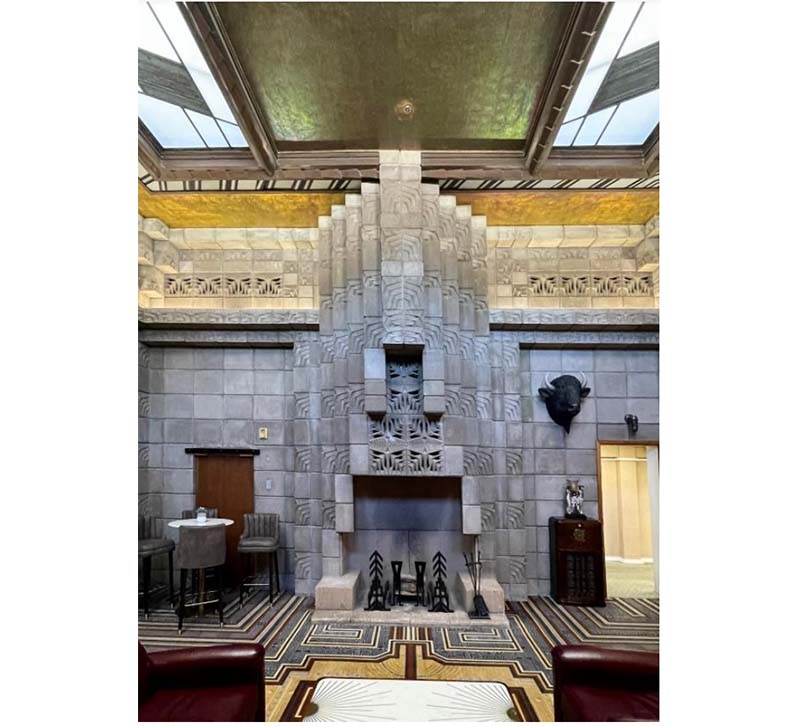I recently got the chance to see the legendary Biltmore Hotel in Phoenix, AZ. This magnificent resort opened its doors on February 23, 1929. They had an opening gala that lasted three days in a row in order to accommodate all of the people who wanted to attend.
Although the architecture is often attributed to Frank Lloyd Wright, it was actually designed by Albert Chase MacArthur, a mentee of Wright. Wright was brought in to consult on the project, though. Reportedly, MacArthur had paid Wright $10,000 to use his patented block design which would be the equivalent of $164,000 in today’s money. But it turned out that Wright did not own the patent which really put a kink in their relationship. For the interior and exterior of the Biltmore, more than 250,000 tile blocks were used. They were produced on site and are still made on site to this day.
In 1929 during the crash of the stock market, the Biltmore ended up getting sold to William Wrigley Jr. of chewing gum fame, who was one of the original investors. The Wrigley family owned the resort until 1973 when it was sold to the Talleys.
Shortly after the sale, there was a huge fire that roared through the hotel during renovations. It was a six-alarm fire to which 35 firetrucks and 150 firefighters responded. Afterwards, construction crews worked 24 hours a day for 81 days to make the repairs and restore the hotel to open on time for the season.
Here are some fun facts:
Irving Berlin wrote the holiday tune “White Christmas“ while lounging poolside at the Biltmore.
Clark
Gable and Marilyn Monroe were visitors. Even though there’s no record of her staying at the hotel, she reportedly liked to go to sunbathe poolside there when filming in nearby Phoenix.
In the 1960s, Frank Sinatra, Liza Minnelli and Sammy Davis Jr. put an impromptu show on in the lobby.
In March 2020 the property underwent a $100 million upgrade. It was fascinating to tour the property and see how beautifully the lighting is incorporated into the overall design

The lobby is a jewel. The lighting does a great job of warming up the concrete walls and columns. It also does enhance the textures of Frank Lloyd Wright tile designs wonderfully.

These caste translucent panels are incorporated into the walls, columns and ceilings throughout the property. Tiny set crews can be removed when changing bulbs. The original incandescent bulbs were replaced with LED versions in a 2700K color temperature which are specifically made for enclosed fixtures.

The reception area is quite inviting. I like how the counters have a linear LED light which grazes the textured tiles on the façade. Period wall sconces and inset back-lit panels add to the overall welcoming feel.


As a part of the latest renovation, new fixtures were selected that were evocative of the original Art Deco design. This fixture is used in the lobby and is an impressive 4’x 5’

The dining room is also spectacular. Original long pendant fixtures help create a human scale for the space which sports a 20 foot ceiling.

In the hallways of the hotel the cast concrete tiles extended out onto the ceiling. In-floor LED uplights were installed to illuminate the detailing above.

One of the jewels of the hotel is the Wright Bar, located just off the lobby. It is where the Tequila Sunrise was created by Gene Sulit in the 1930s. The story goes that a guest asked him to make a cocktail to drink poolside and to surprise him with the flavor. It is made of soda, tequila, fresh lime juice and Crème de Cassis. The density of the cassis caused it to settle on the bottom of the glass which mimicked the look of a sunrise. It is the cocktail that helps you forget to remember.

One of my favorite spots is the Mystery Room. It was built as a speakeasy in 1929 to circumvent Prohibition which lasted from 1920 to 1933. Indirect LED linear cove lighting fills the room with soft ambient light, as do the frosted glass leaded skylights do during the day. It can be rented out for private events for up to 30 people.

The most architecturally spectacular space in the hotel is the Aztec Room. It sports an 18 karat gold leaf ceiling, which is the second largest one in the world. The largest is in the Taj Mahal. Indirect lighting washes over the ceiling to create a luxurious warm feel.
If you do get a chance to visit, do take one of the architectural tours. Then have a tequila Sunrise on me.
All photos courtesy of Randall Whitehead.







